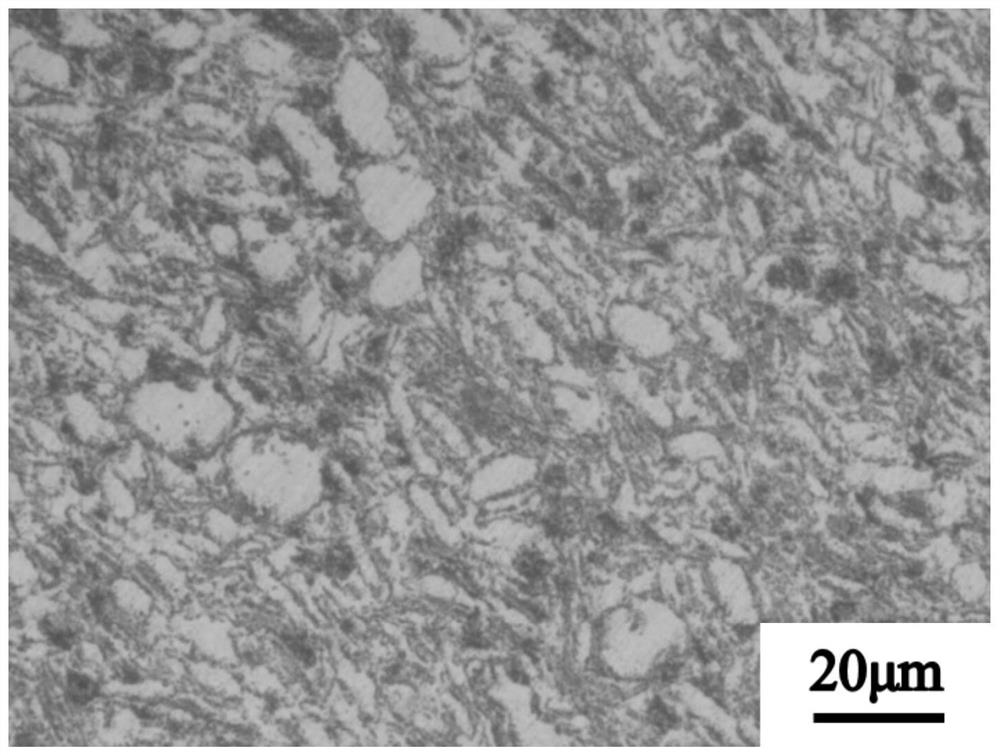Preparation method for dual model-structure graphene-reinforced aluminum matrix composite
A technology for strengthening aluminum-based and composite materials, applied in graphene, chemical instruments and methods, temperature control, etc., can solve the problems of strength-toughness inversion, easy agglomeration of graphene, etc., achieve excellent strength and toughness, and less interface reaction , the effect of shortening the time of heat preservation
- Summary
- Abstract
- Description
- Claims
- Application Information
AI Technical Summary
Problems solved by technology
Method used
Image
Examples
specific Embodiment approach 1
[0024] Specific embodiment one: the preparation method of the dual-mode structure graphene reinforced aluminum-based composite material of the present embodiment is carried out according to the following steps:
[0025] 1. Weighing
[0026] Weighing 1.2% to 1.8% graphene oxide and 98.2% to 98.8% aluminum metal powder as raw materials by mass fraction;
[0027] 2. Preparation and dispersion of three-dimensional graphene
[0028] Add the graphene oxide weighed in step 1 into distilled water for ultrasonic dispersion to obtain a graphene oxide dispersion; add ascorbic acid solution to the graphene oxide dispersion under magnetic stirring conditions to obtain a graphene oxide colloid, and the graphene oxide colloid Carrying out vacuum freeze-drying to obtain a three-dimensional graphene skeleton; mixing the three-dimensional graphene skeleton with the aluminum metal powder weighed in step 1 and then ball milling to obtain a mixed powder;
[0029] 3. Preparation of double-mode st...
specific Embodiment approach 2
[0040] Specific embodiment 2: The difference between this embodiment and specific embodiment 1 is: the average sheet diameter of the graphene oxide described in step 1 is 2 μm to 5 μm, and the average thickness is 5 to 10 nm; the average particle size of the aluminum metal powder described in step 1 The diameter is 10-30 μm.
specific Embodiment approach 3
[0041] Embodiment 3: The difference between this embodiment and Embodiment 1 or 2 is that the aluminum metal powder in step 1 is made of Al-Mg-Si alloy, Al-Cu-Mg alloy, Al-Cu-Mn-Mg alloy, Al-Mn-Si-Cu alloy, Al-Si-Mg-Be alloy; in the Al-Mg-Si alloy, Mg is 0.45-4.8%, Si is 4.5-6.5%, and Cu is 0.6% ~0.8%; Cu in Al-Cu-Mg alloy is 1.5~4.5%, Mg is 0.3~3.8%; Cu in Al-Cu-Mn-Mg alloy is 3.8~4.9%, Mn is 0.3~9%, Mg is 1.5-1.8%; in Al-Mn-Si-Cu alloy, Mn is 4.2-5.6%, Cu is 0.6-0.8%, Fe is 0.1-1.0%, Si is 7.0-12%, and Ti is 0.1-1.0%; Al In the -Si-Mg-Be alloy, Si is 4.5-8.0%, Mg is 0.4-1.5%, Ti is 0.15-0.25%, and Be is 0.15-0.25%.
PUM
| Property | Measurement | Unit |
|---|---|---|
| thickness | aaaaa | aaaaa |
| concentration | aaaaa | aaaaa |
| elastic modulus | aaaaa | aaaaa |
Abstract
Description
Claims
Application Information
 Login to View More
Login to View More - R&D
- Intellectual Property
- Life Sciences
- Materials
- Tech Scout
- Unparalleled Data Quality
- Higher Quality Content
- 60% Fewer Hallucinations
Browse by: Latest US Patents, China's latest patents, Technical Efficacy Thesaurus, Application Domain, Technology Topic, Popular Technical Reports.
© 2025 PatSnap. All rights reserved.Legal|Privacy policy|Modern Slavery Act Transparency Statement|Sitemap|About US| Contact US: help@patsnap.com

